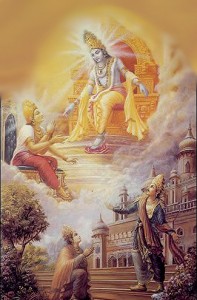Who on the Earth ever thought that life can exist on the Sun? As soon as the Johns Hopkins Applied Physics Laboratory (APL) received a green signal from NASA for its Solar Probe+ mission, the media dubbed it as a mission to touch the Sun. Anyone who had even a faintest idea of what the Sun is, had hard time believing this. After successfully completing its Critical Design Review (CDR) and NASA’s go-ahead, APL’s official website mentioned that the mission will fly closer to the Sun than any spacecraft has done in the past. Furnishing a little more detail on the mission it said:
Scientists have long wanted to send a probe through the Sun’s outer atmosphere, or corona, to better understand the solar wind and the material it carries into our solar system. The primary science goals for the Solar Probe Plus mission are to trace the flow of energy and understand the heating of the solar corona and to explore the physical mechanisms that accelerate the solar wind and energetic particles.
To meet those objectives, Solar Probe Plus will carry four instrument suites into the Sun’s corona and study the solar wind and energetic particles as they blast off the surface of the star. These instruments will study magnetic fields, plasma, and energetic particles, and will image the solar wind. The instruments are: the Fields Experiment from the University of California Space Sciences Laboratory, Berkeley, California; the Integrated Science Investigation of the Sun (ISIS) from the Southwest Research Institute, San Antonio; the Solar Wind Electrons Alphas and Protons Investigation (SWEAP) from the Smithsonian Astrophysical Observatory, Cambridge, Massachusetts; and the Wide Field Imager for Solar Probe Plus (WISPR) from the Naval Research Laboratory, Washington, D.C. (Source http://www.jhuapl.edu/newscenter/pressreleases/2015/150408.asp)

Indeed, mankind has always wondered what is up there on the stars. Moon, Mars, Venus, Sun, passing by asteroids, and many other distant planets and galaxies have kept the scientist community busy guessing about their nature. Given the nature of human brain, it is not the fault of scientists when they come up with changing theories on their understanding of the universe.
When NASA’s Apollo mission returned to Earth they announced that there is no life on the Moon. Every well-equipped astronomer and space scientist knows by now that it was a wrong conclusion. Later on NASA mysteriously abandoned its Moon mission and pointed its telescopes towards Mars and Venus. Their announcement to build a city above the clouds of Venus kindled a new round of curiosity and flares of criticism from different quarters.
“But everything else about it makes it almost utterly unvisitable. While probes have been sent to the planet’s surface, they lasted, at most, just two hours before surface conditions on Venus destroyed them. These conditions include an atmospheric pressure up to 92 times greater than Earth’s; a mean temperature of 462 degrees Celsius (863 degrees Fahrenheit); extreme volcanic activity; an extremely dense atmosphere consisting mostly of carbon dioxide, with a small amount of nitrogen; and a cloud layer made up of sulphuric acid.” (Source CNet.com)
Another analysis published here hurled a blistering attack on such lavish space missions. It started with a most basic question asking why NASA wants to build a floating city on Venus when there is absolutely no scarcity of space for living on the Earth and went on to say that all necessities of life are abundantly supplied by the nature, including hundreds of thousands of hectares of empty land on this planet where human beings can peacefully live and vegetation can naturally flourish. The article claimed the earth is so rich that not only human beings but animals, birds, trees and plants- all can live peacefully in harmony, even if the population were to be doubled. The author believed that such space missions by difference countries are no more than intellectual gymnastic at the cost of public wealth while people on this planet struggle for jobs, food and kill others for mere survival.
Nonetheless, the undeterred NASA continued its mission, not only to Venus but also to the Sun. Modern science believes that the way to find truth is by experiments never mind it takes generations and costs millions, not only dollars but also lives, to find after a few decades that the previous conclusion was wrong. This tradition is not unknown, and modern scientists researchers seem determined to continue with it.
On the other hand, while the Solar Probe+ mission is yet to leave the Earth atmosphere and deliver those stunning images and data of the surface and climate of the sun, we came across a whole new world of science stored in the pages of India’s timeless literature called the Vedas.
In Sanskrit, the language of the Veda, there is something called jñāna and vijñāna (pronounced gyan and vigyan in Hindi). Jnana means knowledge and vijnana means applied knowledge. It is similar to what we know as science and applied science.
It remains a question as to why we have to think that science only means modern science when ancient Vedic science has proven to be much more accurate and advanced.
The most interesting part of Vedic science is, it does not believe in repeating experiments but in hearing from authoritative sources, called sruti. Sruti is the knowledge delivered by those who have seen the truth. The level of accuracy with which these books describe not only the creation, maintenance and annihilation but also regeneration of the universe, is truly mind-blowing. Besides, the information given in there is verifiable by experiments provided the process is followed. If a trusted goldsmith tells you that a particular ornament is made of gold, you don’t need to waste time in testing it in a laboratory. At the same time, if you do the test you are sure to find it to be gold. Vedic science is that simple. The difficulty, however, is that people in general neither want to believe the goldsmith nor do the lab test. Such people remain in constant denial of realities surrounding them.
For example, today the whole world, including philosophers, sociologists, economists, politicians and even scientists consider Bhagavad Gita as an authentic source of wisdom but they forget that the same Lord Krishna, the main speaker in Bhagavad Gita, says in the same book how, before millions of years, He had given the same knowledge to the ruler of the Sun planet, named Vivasvan.
imaṁ vivasvate yogaṁ proktavān aham avyayam
vivasvān manave prāha manur ikṣvākave ’bravīt
TRANSLATION: “I instructed this imperishable science of yoga to the sun-god, Vivasvān, and Vivasvān instructed it to Manu, the father of mankind, and Manu in turn instructed it to Ikṣvāku. ” (B.G. 4.1)

How could Lord Krishna speak to the ruler of the Sun if there was no life there? Life is still there on the sun. Vedic scriptures confirm that during the current millennium, or yuga, King Vivavan is ruling the sun planet, which is the origin of all planets within our solar system. It is also mentioned in Brahma-saṁhitā (5.52) that the sun is the king of all planets within this universe:
yac-cakṣur eṣa savitā sakala-grahāṇāṁ rājā samasta-sura-mūrtir aśeṣa-tejāḥ
yasyājñayā bhramati sambhṛta-kāla-cakro govindam ādi-puruṣaṁ tam ahaṁ bhajāmi
TRANSLATION: “Let me worship,” Lord Brahmā said, “the Supreme Personality of Godhead, Govinda [Kṛishna], who is the original person and under whose order the sun, which is the king of all planets, is assuming immense power and heat. The sun represents the eye of the Lord and traverses its orbit in obedience to His order.”
Mahābhārata (Śānti-parva 348.51–52) also confirms that Bhagavad Gita was first spoken to Vivasvan, the ruler of the sun planet:
tretā-yugādau ca tato vivasvān manave dadau
manuś ca loka-bhṛty-arthaṁ sutāyekṣvākave dadau
ikṣvākuṇā ca kathito vyāpya lokān avasthitaḥ
Meaning, in the beginning of the millennium known as Treta-yuga this science of the relationship with the Supreme was delivered by Vivasvan to Manu. Manu, being the father of mankind (manusya), gave it to his son Maharaja Ikṣvaku, the king of this Earth planet and forefather of the Raghu dynasty, in which Lord Rama appeared.
We also find an incident recorded in Mahabharat how, during Dvapara yuga, the Sun-god blessed mother Kunti with a powerful son who later became known as Karna and was killed by Arjuna in the battlefield of Kuriksetra (which still exists in India). How can we ignore these real personalities who walked on the Earth, some of them just 5000+ years ago? This is the same Arjuna who heard Bhagavad Gita from Lord Krishna, and, as mentioned earlier, it is the knowledge which was received by sun-god Vivasvan some 120,400,000 years ago.
“At the present moment we have just passed through five thousand years of the Kali-yuga, which lasts 432,000 years. Before this there was Dvapara-yuga (800,000 years), and before that there was Treta-yuga (1,200,000 years). Thus, some 2,005,000 years ago, Manu spoke the Bhagavad-gita to his disciple and son Maharaja Iksvaku, the king of this planet earth. The age of the current Manu is calculated to last some 305,300,000 years, of which 120,400,000 have passed. Accepting that before the birth of Manu the Gita was spoken by the Lord to His disciple Vivasvan, the king of the sun planet, a rough estimate is that the Gita was spoken at least 120,400,000 years ago.” (Srila Prabhupada purport B.G 4.1)
Vedic science firmly declares that there is life on the Sun. In fact, not only on the Sun, it says that all the planets in the universe, both visible and invisible to human eyes and instruments, are filled with living entities.
We find the following statement in the Vishnu Purana (1.3.2):
śaktayaḥ sarva-bhāvānāmacintya-jñāna-gocarāḥyato ‘to brahmaṇas tās tusargādyā bhāva-śaktayaḥbhavanti taptatāṁ śreṣṭhapāvakasya yathoṣṇatā
Translation: All the creative energies, which are inconceivable to a common man, exist in the Supreme Absolute Truth. These inconceivable energies act in the process of creation, maintenance, and annihilation. O chief of the ascetics, just as there are two energies possessed by fire namely heat and light these inconceivable creative energies are the natural characteristics of the Absolute Truth.
The creative energy mentioned above refers to life. Lecturing on this verse, the founder-acharya of ISKCON, A.C. Bhaktivedantas Swami Prabhupada said in London on July 23, 1976:
“We get information from the śāstra that every planet is full of living entities. Every planet. Jana-kīrṇa. This very word is said in the Śrīmad-Bhāgavatam, jana-kīrṇa, and there is a vivid description of different planets and different types of oceans, just like milk ocean. We have got here examples, sweet water and salted water. So there is sweet ocean also. That is mentioned in the śāstra. Not that in this planet there is salted ocean and… There are other planets where there is sweet-water ocean and milk ocean and liquor ocean and oil ocean, ghee ocean, butter ocean, milk…, butter ocean, and so many different types.”
Scriptures advise na tas tarkyena yojayet (CC Adi 17.308, Maha Bharat, Bhiṣma parva 5.22), meaning those things which are beyond your conception, don’t try to understand it by your so-called logic and argument.
It is not difficult to understand how there can be life on the sun. We have seen living entities on the earth, in the water. We also got experience of living entities being produced in air. There are five fundamental gross elements; earth, water, fire, ether (space) and air. If earth is supporting life, if water is supporting life, if air is supporting life, space is supporting life, then why not fire?
Even a layman knows that fire is fueled by oxygen, so where is the difficulty in understanding that there can be living entities who can breathe oxygen in fire? When Vedic science and history of the universe mentioned in the Vedas confirm that there is an advanced civilization on the sun planet, it means there is one. In fact, as mentioned above, the word jana-kīrṇa suggests that it is congested with living entities. The difference between ours and their bodily structure is, bodies on earthly planets are predominantly made of earth or water element, and the bodies of living beings on the sun are made primarily of fire element. This is the main reason they are able to survive and live a normal life on the sun.
The Solar Probe+ mission will take its own time, with no guarantee, whatsoever, as to what it will find, and the science as we know it today will also take its own time to conclusively understand more of the sun planet. Under the circumstance, it would be wiser to accept Vedic science as an authentic source of information on all faculties of science and the science behind this universe while carrying out research works for those stuck with empiricism. That will save our sincere modern scientists a lot of time and energy, save tons of taxpayers money, and the researchers will have a less frustrating experience with their ongoing experiments.




































